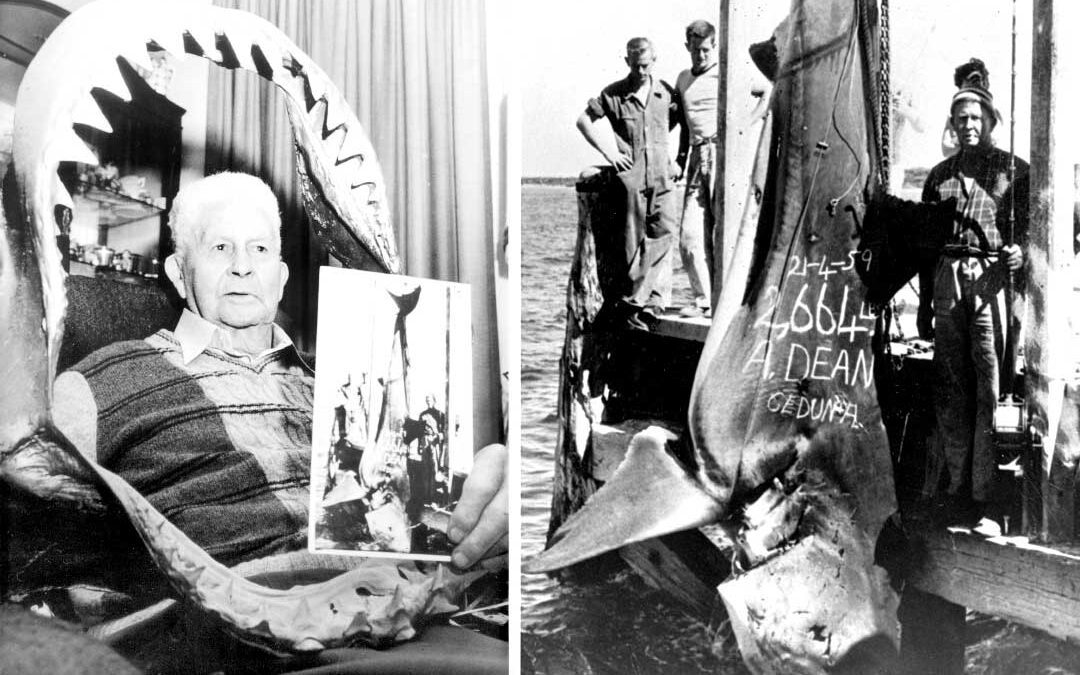Let’s face it. You have to be a more than a little nuts to fish for 2,000-pound white sharks with rod and reel. The whole idea sounds insane, rather like diving the Marianas Trench with mask and flippers or hunting Siberian tigers with a squirt gun. Aficionados of the sport must be folks with histories of irrational behavior: former test pilots, say, or retired WWF champions. Putting aside for a moment the preposterous assumption that fish the size of trolley cars really can be battled into submission on wispy lines, what do you do with the damn things once they’re alongside the boat? Take a picture and hope they don’t respond by killing you and everyone you know? Put on a feed for the city of Cleveland? There are definitely some issues with the sport, but years ago it had its enthusiasts – and none were greater than Australian Alfred Dean.
Despite the white shark’s fearsome reputation as a man-eater, it’s in fact rather less impressive when hooked on sporting tackle. As a result, relatively few anglers have ever pursued the species with much vigor. For his part, Alf Dean did not take up big-game fishing until after WWII when he was already middle aged.
Dean’s father was a legendary Aussie bushman who studied and emulated the techniques of local Aborigines. Alf grew up hunting and fishing, even keeping a gun in his locker at school so he could shoot ducks and rabbits after class. Once, when nabbed by an understanding warden with a brace of out-of-season ducks, he was released after pleading that he’d only fired in self-defense after being attacked by the berserk waterfowl. Clearly, this was a young man bound for shark-fishing greatness.
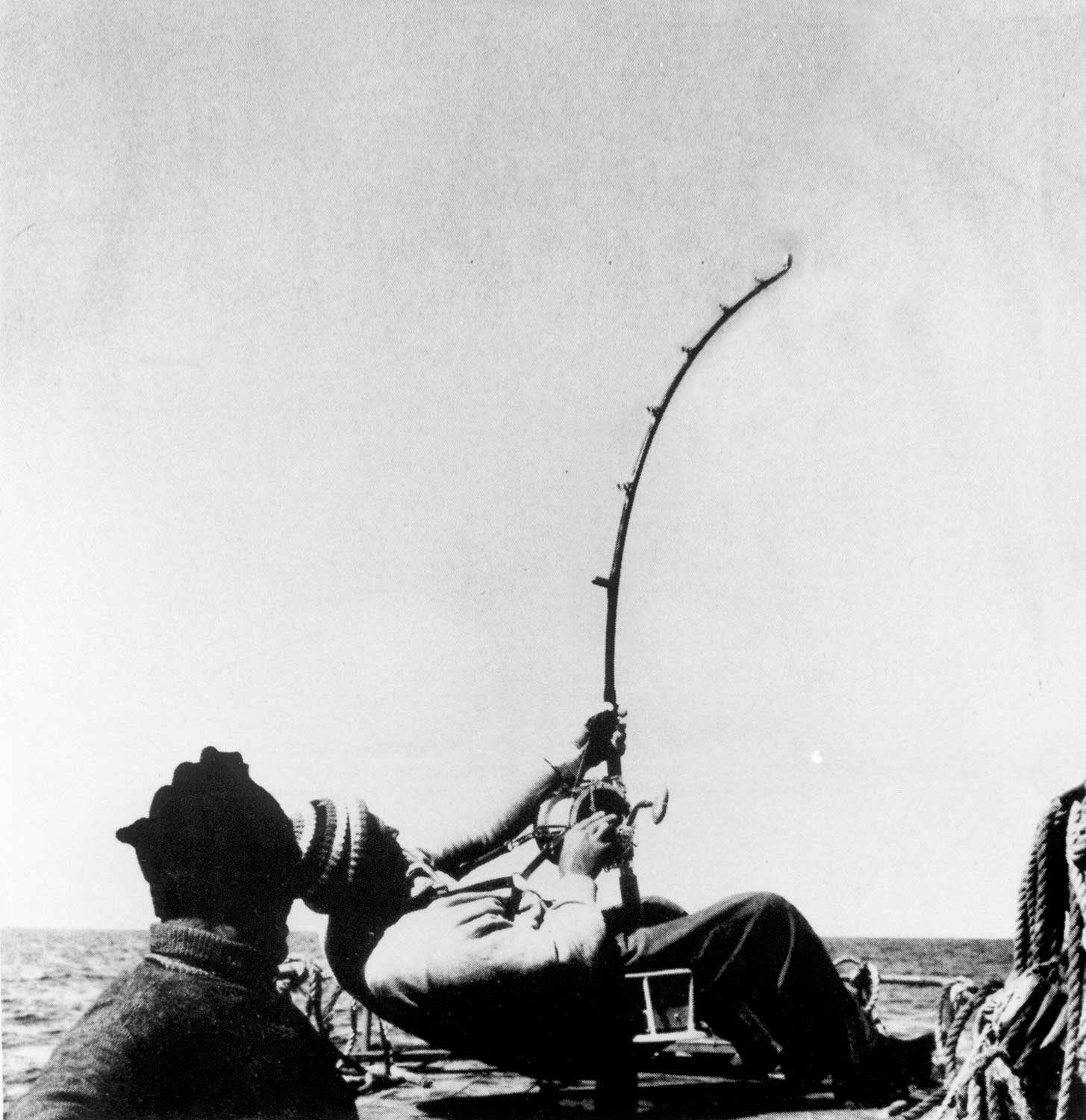
A citrus farmer and horticulturist by trade, Dean was a burly fellow with piercing eyes, protruding ears, a square chin and a nice head of sandy hair that turned white in later years. His oft-stated goal was to catch the largest fish in the sea. Since whale sharks and basking sharks are both filter- feeders and will not bite a baited hook, he turned to number three: great white sharks (known as white pointers in Australia). Ultimately, of the seven largest sharks ever taken on conventional rod and reel – each weighing more than a ton – Dean would capture six. Pretty good for a fellow who fished only two weeks a year.
His success was no accident. Dean was meticulous about his tackle, trying and discarding gear from all the makers of the day. His preferred rig was all-American: huge Penn reel, stiff Silaflex rod and heavy Ashaway linen line. His hooks of choice were the largest available from Mustad of Norway – gigantic models that measured a full nine inches across. As Dean’s expertise grew, he commissioned local experts to build up his tackle to even more Herculean proportions: oversized reel seats, industrial strength roller guides and reinforced fighting chairs.
For monster sharks, Dean favored the time-honored bait-and-switch technique. Huge chunks of porpoise, seal or whale meat (Dean would later opine that great whites liked greasy food) would be left dangling in the water, only to be snatched away on the approach of a hungry shark. Once frenzied, the great beast would circle around and attack anything put in its path.
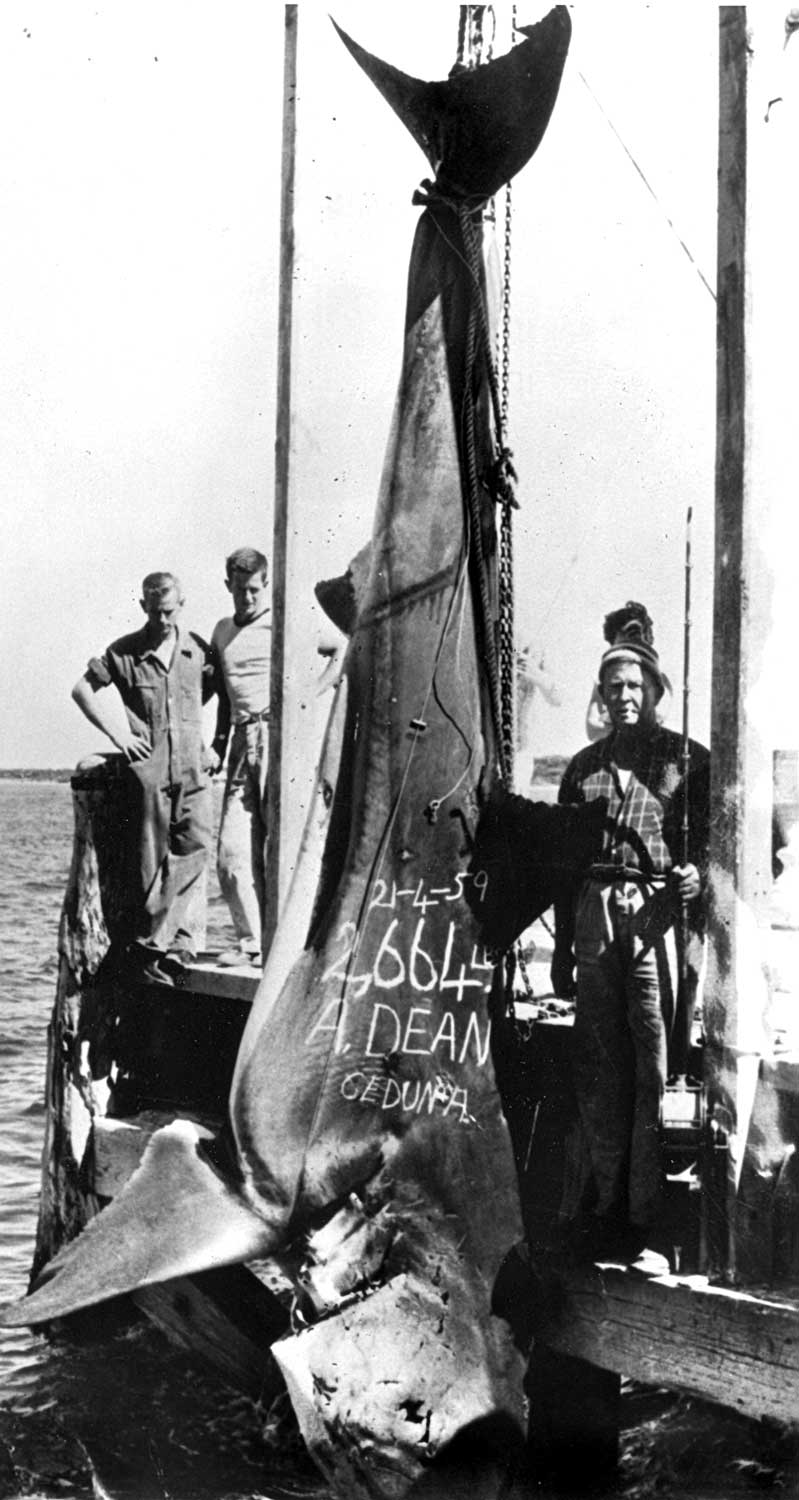
This great white shattered the previous all-tackle record by more than 1,000 pounds.
Alf Dean was well prepared on his record-setting day in the fall of 1959. No fancy gear: just two enormous Mustad 18/0 hooks and a Penn 14/0 reel crammed with 130-pound test line. A steady drip of blood and whale oil over the side left a flavorful slick that drifted for miles. Partly as a result of its effectiveness, the use of mammal meat as bait or chum was subsequently banned by the IGFA, and remains so to this day. Nonetheless, these enticements were perfectly legal in Dean’s time, and charter captains often debated the efficacy of using sheep versus cattle meat, porpoise over seal.
For his part, Dean was already among the elite of his sport, having set three world records, the last an astonishing 2,536-pound white shark four years before. He’d lost even bigger fish and was eager to raise the bar again.
Armed with the requisite gore, Dean boarded Ken Puckridge’s charter boat Victory on a crisp autumn morning and off they went. The two men began fishing at Dangerous Reef off the coast of South Australia, an area noted for the long-time presence of a whaling station. On this trip, seal meat was the odor of choice, but for some reason it failed to work.
The men fished for nine days without a strike. Finally, at 4 a.m. on their last morning, a huge shadow slid under the boat just as Puckridge was down below brewing a fresh pot of coffee. Dean thought he felt a nudge on his line and tossed more offal into the water. A few tense minutes passed and the fish reappeared – an enormous black silhouette nearly 17 feet long.
When the chum was removed from the water and a baited slab of Flipper meat presented in its place, the shark never hesitated and the battle was joined. The brute moved off down the coastline, but quickly tired under steady pressure. Remarkably, there were few tense moments and no near-disasters.
After barely an hour, punctuated by two spectacular leaps, the record-book shark was secured. The eight-mile tow back to Denial Bay for the weigh-in was slow but uneventful.
Alerted by ship-to-shore radio, a crowd had gathered on the dock to gape at the mammoth fish as it was hoisted from the water and weighed. The big scale read 1,208.38 kilograms, or 2,664 pounds.
Already recognized as “the world’s greatest shark fisherman,” Dean’s celebrity was ensured for all time with this singular catch. Of the thousand-plus species on the IGFA’s all-tackle record list, none has ever come within 750 pounds of his incredible record.
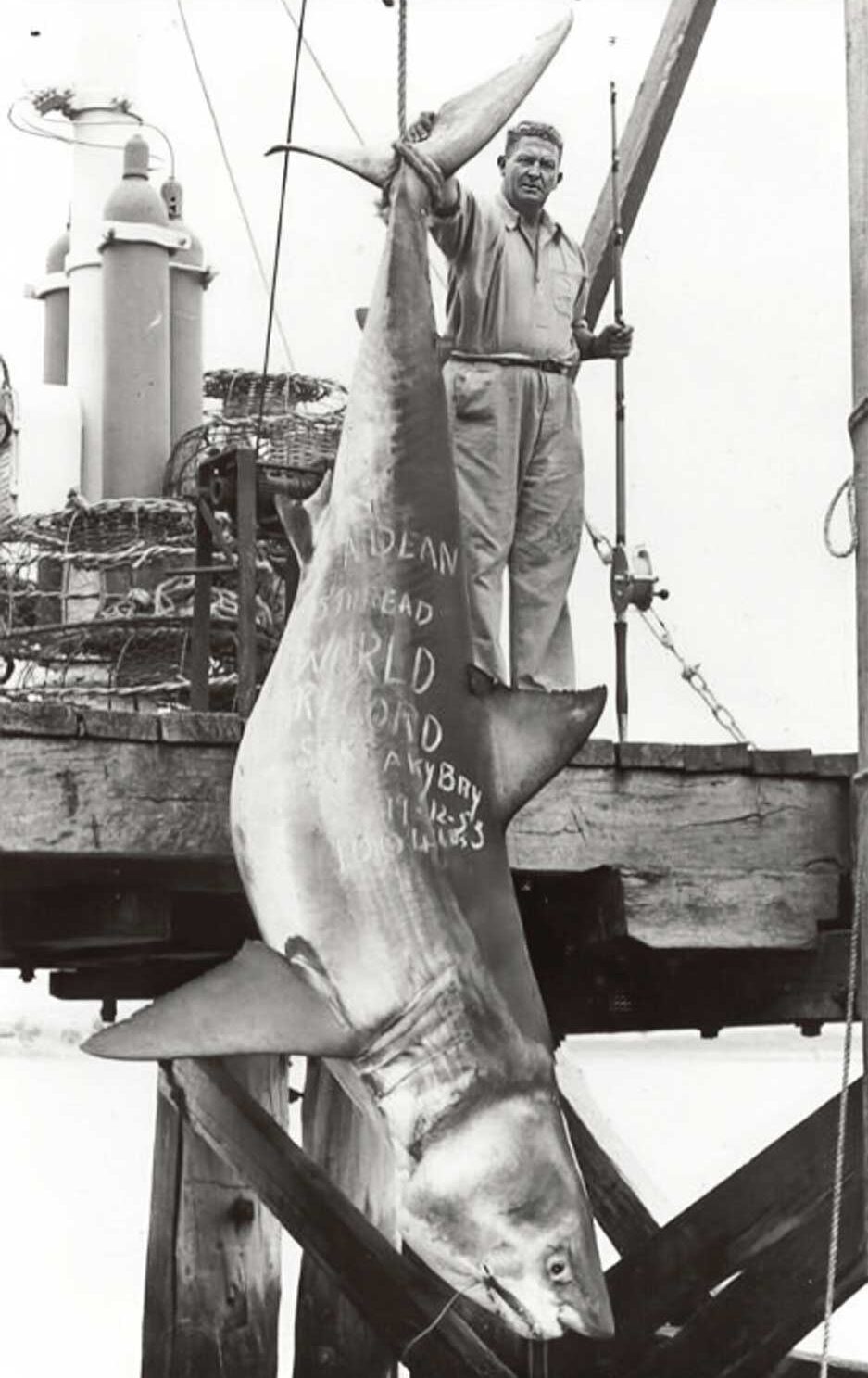
Alf Dean poses with a 1,004-pound great white caught in November, 1953. The huge fish became the new IGFA record in the 50-pound line class.
Dean continued to fish for a few more years, but never bettered his own mark. By the time of his dotage he had a million shark stories: how a shark he captured in 1960 still had Dean’s distinctive hook and leader embedded in its jaws from a battle two years before; how he’d lost an estimated 5,000-pounder in 1954 after a bruising five-and-a-half hours; how his first big shark was caught on a splintered cane rod stiffened with a broom handle; how one time he lost his balance in rough seas and wound up in the midst of his own bloody chum line. And then there was Barnacle Lil – the quintessential big one that got away.
According to legend, Barnacle Lil was the doyenne of white sharks, the mother of all mothers. She was originally tagged as Barnacle Bill, but Dean, who was a keen observer of gamefish, changed the name after identifying her as a female. An estimated 20 feet long and weighing more than 4,000 pounds, Lil was easily identified by a distinctively scarred gill cleft that was first noticed by local snapper fishermen who had lost many catches to the giant predator.
Dean hooked the shark in 1952 while fishing with his wife and a boatful of media people. Lured into taking a rigged bait, Lil fought for more than an hour before tiring near the boat. With the end almost at hand, Dean’s reel seized and the line popped like a firecracker. Lil slowly swam out of sight.
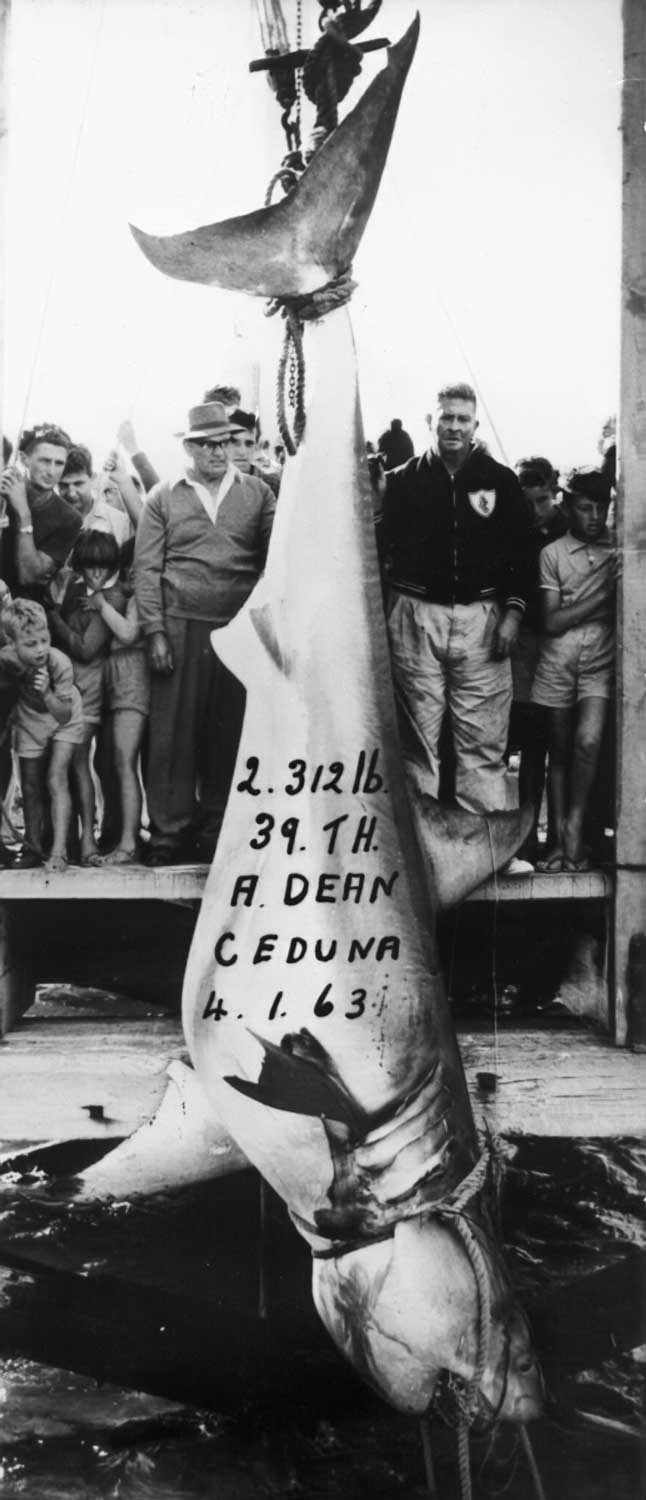
Over his long angling career, Alf Dean caught six great white sharks weighing a half-ton or more. In 1963 he came close to beating his 1959 all-tackle record with this 2,312-pound giant.
Dean saw the fish once more in the 1960s, but could not induce her to bite. In later years he would wax longingly about the huge shark and even penned a few engaging pages about their encounters in a 1966 book about angling in Australia.
Dean died in 1991, proud of his achievements, but quick to acknowledge that the circumstances surrounding his records were no longer in place. The world had changed.
Indeed it has. In fact, the world has come to take a dim view of angling for white sharks. Despite its top-of-the-food-chain status, the species is both relatively rare and easily over-exploited. Furthermore, unlike mako and thresher sharks, there is little to be said for its fighting qualities or the edibility of its flesh.
Fishing for white sharks has since been banned in Australia, South Africa, the U.S. and elsewhere, once again allowing this ultimate predator to survive unfettered. In the end, some fish are best left un-caught.
GREATEST OF THE GREAT
Perhaps the best part of the IGFA’s grand angling museum in southeastern Florida is the Hall of Fishes, a majestic space where viewers look up to view life-size mounts of many of the great world record fish. Dean’s 2,664-pound monster is ostensibly up there, menacing all the rest. However, when the display was being assembled, it was discovered that no true-to-size reproduction of his record catch had ever been made. As a result, inquiries were made of fisherman Frank Mundus of Jaws fame to see if the IGFA might borrow his 3,600-pound shark mount instead. He assented, and the much larger fish was hoisted in place. Shortly thereafter, the museum opened in 1999 with a gala reception attended by a host of angling celebrities, including Dean’s aging widow.
When Dean’s putative catch was pointed out to her, the ever-loyal spouse could only glance up and sniff, “It’s a big one alright, but of course my husband’s fish was much bigger than that.”
Note: Mike Rivkin has written five books on the history and art of big-game fishing. This article originally appeared in the 2012 September/October issue of Sporting Classics magazine.

